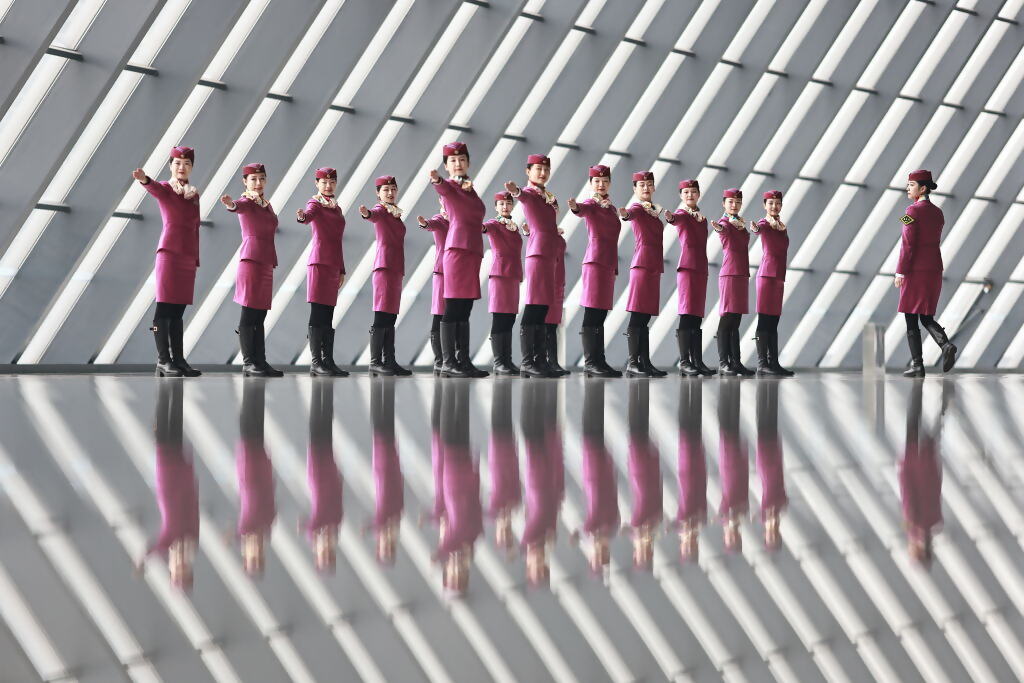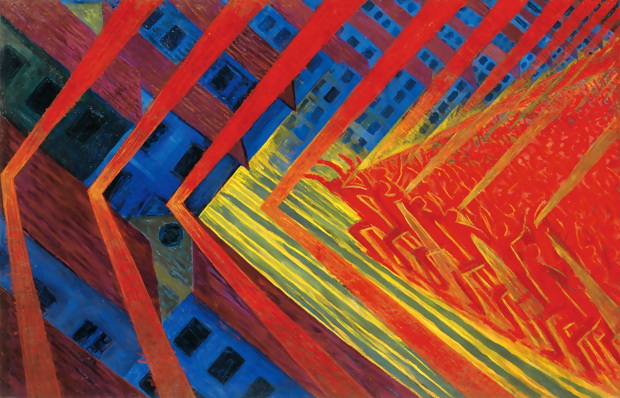
In the latest of our Deep Focus series, where we look closely at a seemingly simple photograph, we compare orderly train attendants in China, with Luigi Rossolo’s The Revolt.
‘A revolution won is a revolution lost’, wrote the architecture critic Ada Louise Huxtable in 1975. She was talking about how avant-gardes get sucked into the mainstream: when a radical style or ideology becomes acceptable, Huxtable says, victory is always mingled with vanquish. Once the revolution has been won, there is no revolution to fight for anymore.
Yesterday’s photograph of high-speed train attendants in China participating in customer service training at an ultra-modern railway station in Chongqing is a reminder of Huxtable’s aphorism. Compare the photo with the futurist artist Luigi Russolo’s 1911 painting The Revolt. At first glance, the two images have little in common: the first is sharp, monochrome, and ordered; the second is rough, colourful, and chaotic. But look again and you’ll notice that photo and painting share two distinctive motifs.
The first is graphic: each image pulses to the rhythm of its regular chevrons, those beams of cold metal that, in the photo, shoot off at right angles as they hit the polished floor of the railway station. Showcasing cutting-edge architecture, this image – a publicity shot for Chinese modernism – represents a high-tech, high-speed China of the future.

The Revolt Luigi Russolo
In Russolo’s painting, the same lines are created from thick bands of red paint, and, though more abstracted, they signal something similar: speed, technology, modernity, and futurity. Those hard diagonals appear in much futurist art of the time to symbolise the march of mechanised progress. Here, in The Revolt, they blast like a trumpet in bold contrast against the melancholy blue houses of European tradition.
Then there are the bodies. In the Chongqing photo, our eye is immediately drawn to the regimented rows of train attendants, each dressed in identikit pink, right arm outstretched, the same half-smile printed on doll-like faces. In this photographic masterstroke, the figures have merged with their surroundings: like those regular beams, the women, too, are perfectly uniform, their ghostly doubles reflecting in the shiny floor beneath them like some dystopian counterpart to this techno-topia.
The bodies in Russolo’s painting aren’t as immediately discernible: a quick look at the painting might suggest only an abstract blur of shape and colour. But, like the Chongqing photo, The Revolt also stages a synergy between body and technology. A red mass of bodies – the same colour as those hard and fast diagonal beams – are storming into the painting from the right, creating a sharp arrow oriented towards the future. Impersonal and identical, these bodies are here to serve a revolutionary purpose: the individual is irrelevant; what matters is the rushing tide of progress.
Russolo’s 1911 painting does not depict the Chinese Communist Revolution, but it does capture a moment in 20th century history when popular rebellions and insurgencies swept the globe. In China, the revolution succeeded with establishing the People’s Republic in 1949. But a revolution won is a revolution lost. As the Chongqing image reminds us, the once-radical iconography of revolt has been chewed up and spat back out as something smooth, shiny and, in the end, sterile.
The revolution is dead – long live the revolution!


